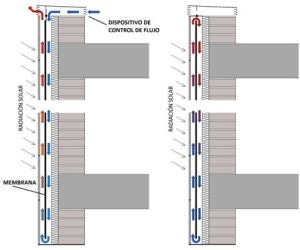Nov 13 2017
A ventilated façade with a double chamber and flow control device has been created by two researchers from School of Building Engineering at UPM. This recent innovation considerably saves energy in buildings, and is a sustainable and efficient solution that can be applied in both rehabilitation works and new buildings because of its ease of implementation.
 Graphic of the facade functioning in summer (left) and winter (right). Credits: Jaime Santa Cruz and César Porras.
Graphic of the facade functioning in summer (left) and winter (right). Credits: Jaime Santa Cruz and César Porras.
The façade is the central constructive element of a building that allows engineers meet the demands of energy efficiency and interior comfort fixed in the national and international standards and directives of the construction sector. The type of system, the design and the proper execution of the façade itself are major aspects that control the final energy consumption of the building.
At present, the air flow expenses are of 40% - 65% of the overall expenses of a building. Buildings located in a Mediterranean-continental climate like in Spain suffer in winter energy losses through their north and east façades because of low temperatures. Similarly, these buildings in summer acquire energy gains through their west and south façades because of solar radiation. In both cases, the air flow is necessary in the building to maintain appropriate inner conditions for their inhabitants, counteracting the energy gains-losses via the building envelope.
To enhance the energy efficiency of façades, two researchers from the group of Tecnología Edificatoria y Medio Ambiente (TEMA) at UPM have designed a new system of ventilated façade. Presently, the conventional ventilated facades are made up of an inner sheet, ventilation chamber, thermal insulation, and exterior finish.
The newly designed façade adds a second air chamber between the current one and the façade insulation. Both chambers are connected by the bottom of the façade. Another feature is an innovative element at the top to control the air flow in the chambers, based on the gradient of the temperature outside and inside the building.
Ventilated façade with a double chamber offers two improvements over the conventional system. Primarily, energy gains-losses are decreased through the façades reducing, consequently, the energy consumption because of air flow. Secondly, the system’s design helps to minimize the vertical temperature gradient along the envelope, homogenizing the air temperature in the chambers during the course of the year.
By reducing the vertical thermal gradients, universal consumption because of energy gains-losses through the façade relies less on the building’s height, preventing the upper houses to present lower or higher indoor comfort and degree of energy efficiency than the lower houses. Moreover, this system is a sustainable and efficient solution that can be applied in both new buildings and rehabilitation works because it is easy to implement.
The primary cost can be short-term amortized if the energy savings of this design are taken into consideration.
The authors of this research say, “This research work highlights the potential energy efficiency of buildings through the redesign of conventional construction systems”.
Details of the work have been recently published in the Energy and Buildings journal and have also been patented.